How to classify sheep carcases
Updated 25 November 2025
Applies to England and Wales
This guidance applies to approved slaughterhouses in England and Wales which either:
- slaughter at least 2,000 sheep per week as a rolling annual average
- slaughter between 1,000 and 1,999 sheep per week as a rolling annual average, and volunteer for the regulations to apply to them
Find out more about the sheep carcase classification requirements.
Slaughterhouses must make sure that carcases of sheep aged less than 12 months are classified on their conformation and fat cover.
For each carcase classified, slaughterhouses must:
- categorise, present (dress and hang), weigh and classify its conformation and fat cover
- keep full records of it
- label it
- communicate the classification results to its supplier
- report the price to the Agricultural and Horticultural Development Board (AHDB)
Only a licenced classifier can classify sheep carcases.
Licence to classify carcases
Slaughterhouses must use a licenced classifier to classify carcases when slaughtering sheep. The classifier can be a slaughterhouse employee or an external contractor. They must be suitably qualified and have a valid licence issued by RPA.
Apply for a classification licence
To apply for someone to become a licenced classifier, follow these steps:
-
Make sure that the applicant classifier has the right to work in the UK. Read the Right to work checks: an employer’s guide to help you do this.
-
Download and complete the SCC2 - Sheep Carcase Classification - Application for an SCC Classifier Licence.
-
Get 2 passport photographs of the applicant classifier. You must get one of these endorsed by the applicant’s manager. More information about endorsing the photograph can be found in the application form.
-
Post the completed form together with the 2 passport photographs to: Meat Technical Schemes, Rural Payments Agency, Eden Bridge House, Lowther Street, Carlisle, CA3 8DX.
Classification test
An RPA inspector will check that the applicant understands the regulations. They will arrange for them to take a test which involves grading sheep carcases. If the applicant passes the test, RPA will issue them with a licence.
Follow-up checks
Once issued, classifiers must carry their licence with them when classifying carcases and show it to RPA inspectors if they ask to see it.
Inspectors will check the standard of classifiers’ work during routine inspections. They will check at least that:
- carcases are correctly identified and presented, including being dressed in-line with approved dressing specifications
- carcases are appropriately classified
- carcase weights have been accurately recorded
- the carcase has been labelled correctly
If classifiers fail these inspections, their licence may be suspended, revoked or altered. Classifiers will need to take another test to prove they can meet the required standard. RPA may arrange additional inspection visits to make sure classifiers are compliant with the regulations.
Automated grading methods
Automated grading methods cannot currently be used to classify sheep carcases. The Department for Environment, Food & Rural Affairs (Defra) can start to consider applications for the use of automated grading methods from February 2027.
To use Defra approved automated grading methods, you will first need to get an automated grading licence from RPA. More information about this process will be available in due course.
Present the carcase
You must present each carcase of sheep aged less than 12 months for classification by hanging from hooks or gambrels and preparing it in line with either:
- reference specification
- UK standard specification
You must not use a custom or tailored ‘company’ dressing specification.
Reference specification
This is the presentation of the carcase after removing the:
- head - severed at the atlanto-occipital joint
- feet - severed at the carpometacarpal or tarsometatarsal joints
- tail - severed between the sixth and seventh caudal vertebrae
- udder
- genitalia
- liver
- pluck
UK standard specification
This is the presentation of the carcase after removing the parts for reference specification above, plus removing the:
- kidney knobs
- channel fat
- diaphragm
Examples of dressing requirements
The below images are for illustration purposes only. They support the documented requirements for each of the specifications above.
Head removal
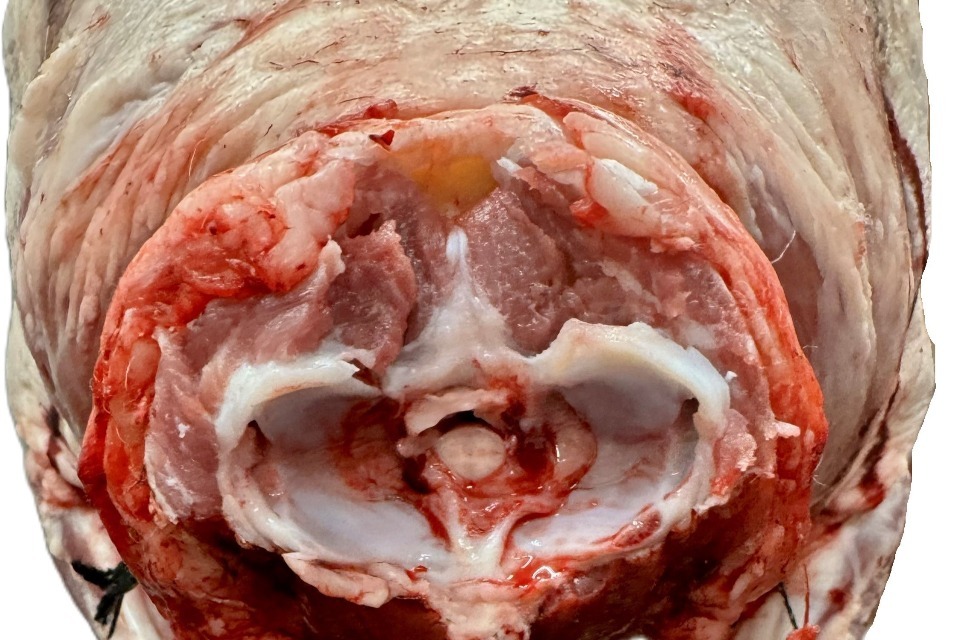
Image showing the correct presentation of head removal, severed at the atlanto-occipital joint.
Front foot removal
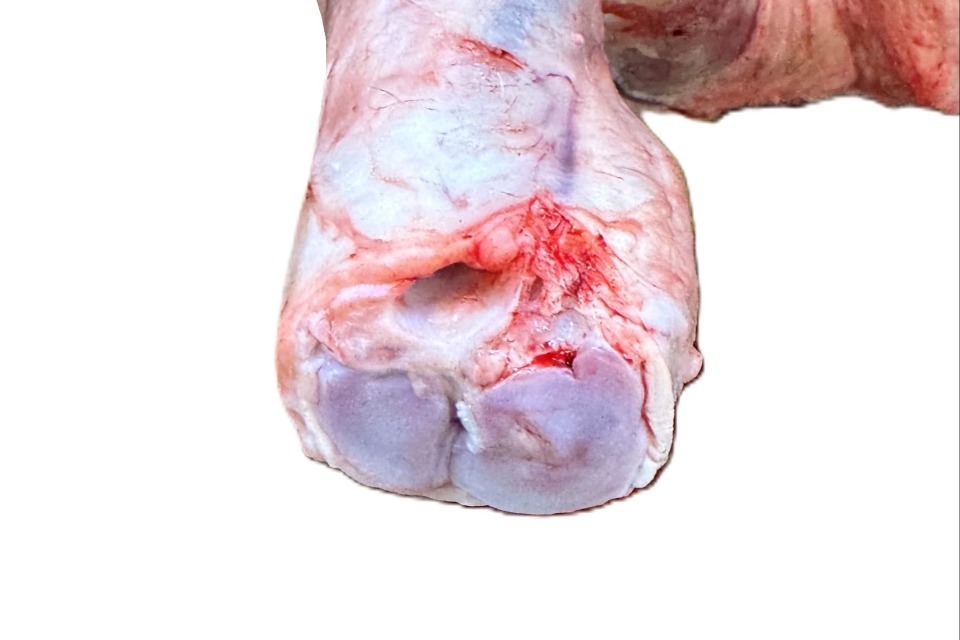
Image showing the correct presentation of the front foot, severed at the carpometacarpal joint.
Hind foot removal
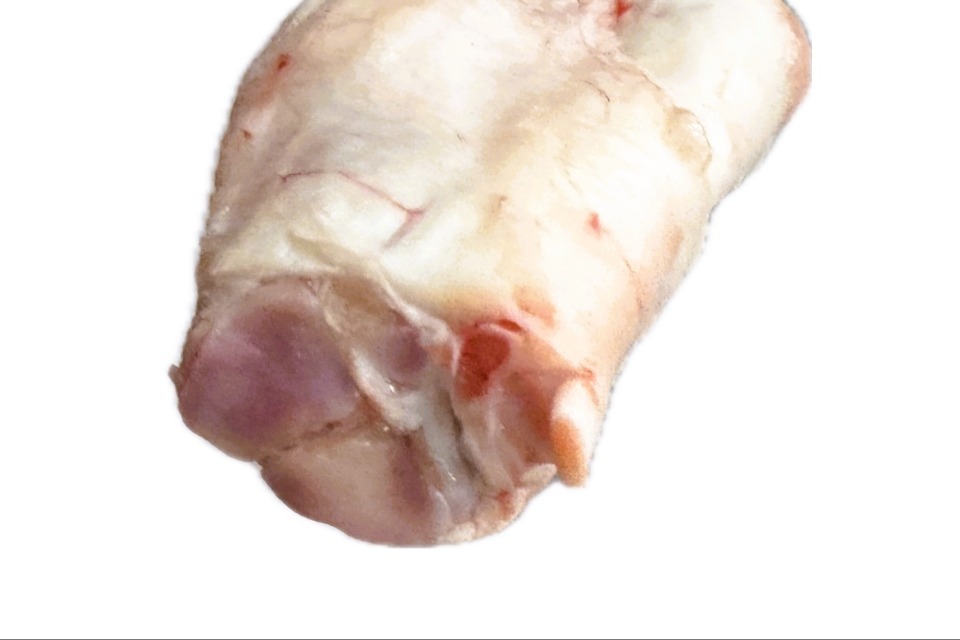
Image showing the correct presentation of the hind foot, severed at the tarsometatarsal joint.
Tail
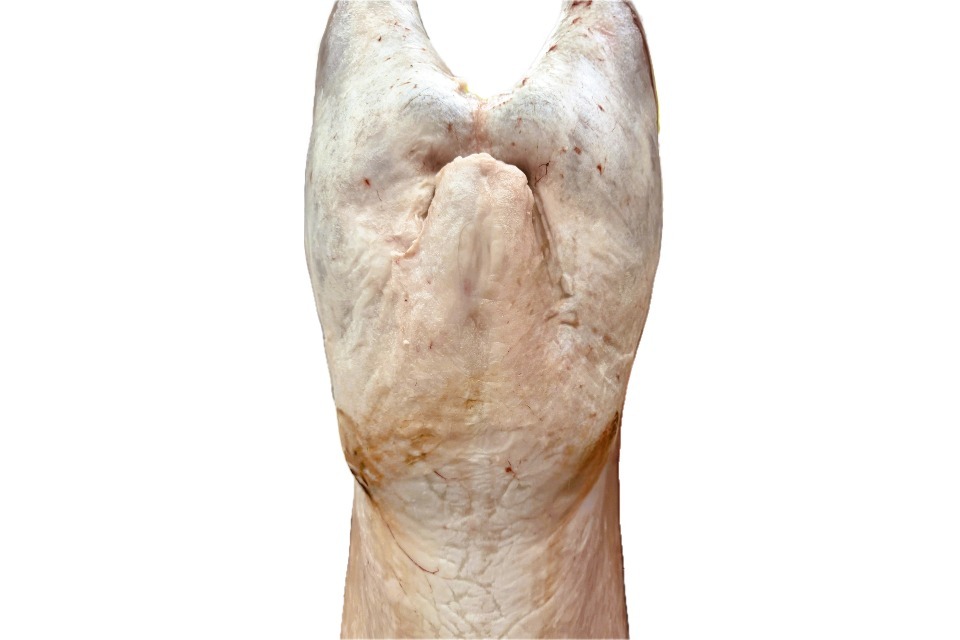
Image showing the correct presentation of the tail, severed between the sixth and seventh caudal vertebrae. When the severed tail is pushed towards the carcase, it should cover the entrance to the back cavity.
Udder and genitalia removal
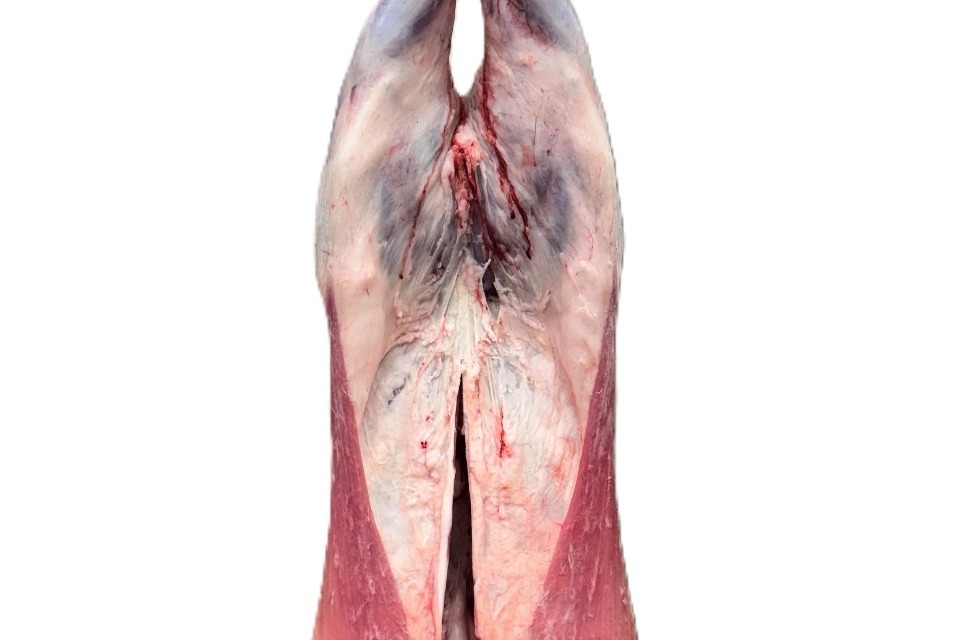
Image showing the correct presentation of the removal of the udder and genitalia.
Pluck
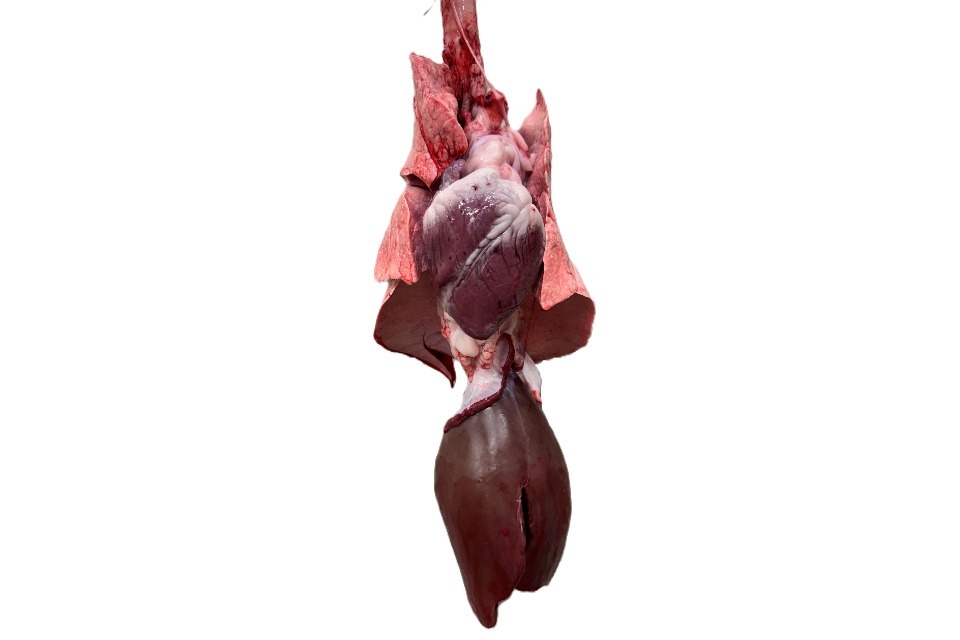
Image showing the correct presentation of the pluck, including the trachea, lungs, heart and liver.
Neck
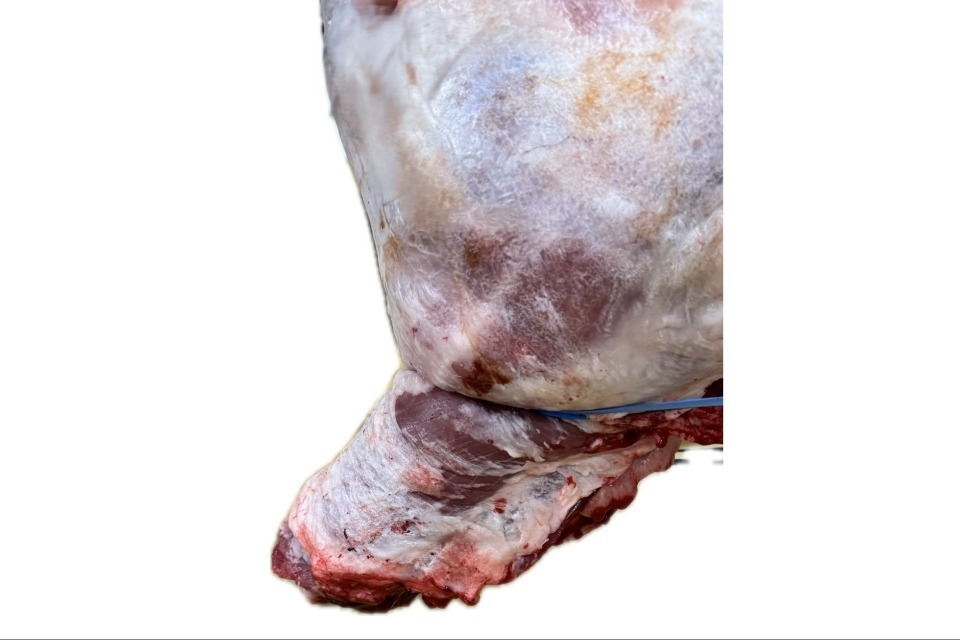
Image showing the correct presentation of the neck after removal of the trachea with all adjacent fat, muscle and tissue left intact. You must not remove any tissue from the neck area unless it is to meet veterinary requirements.
Kidney knobs, channel fat and diaphragm left in
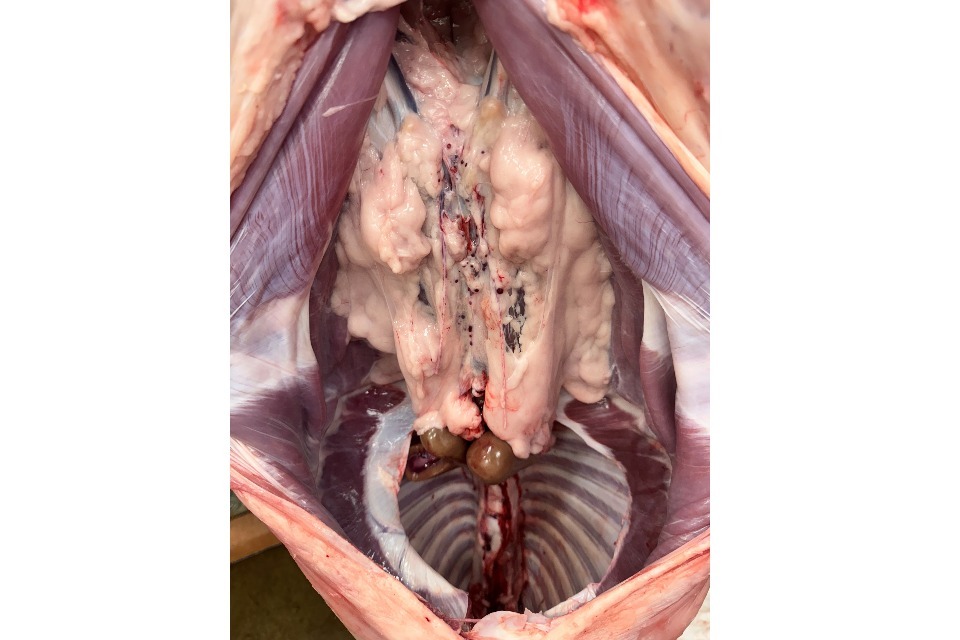
Image showing the correct presentation of the carcase with kidney knobs, channel fat and diaphragm left in for reference specification.
Kidney knobs, channel fat and diaphragm removed
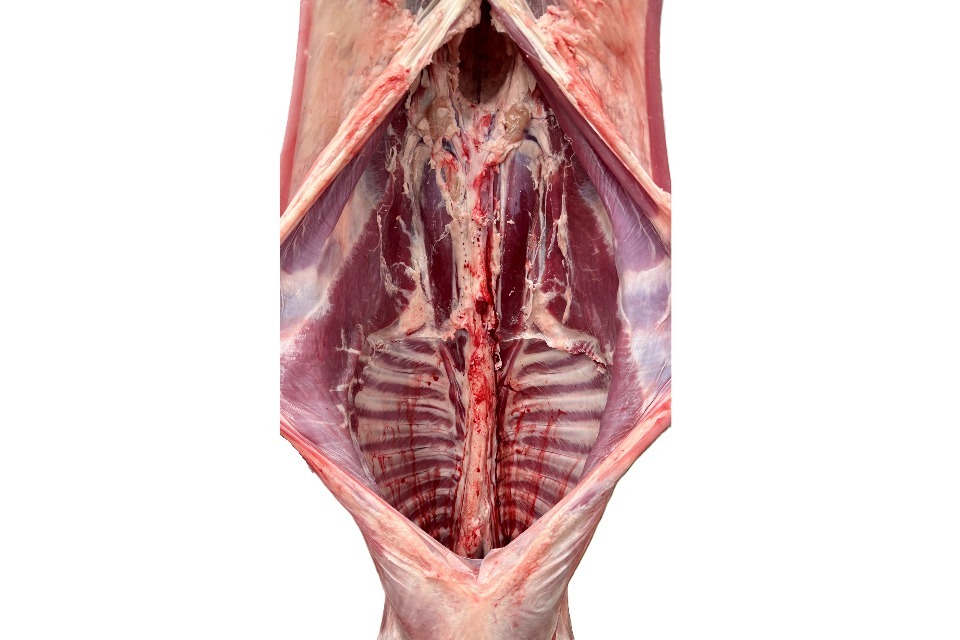
Image showing the correct presentation of the carcase, with kidney knobs, channel fat and diaphragm removed for UK standard specification.
Categorise the carcase
You must identify whether carcases of sheep aged less than 12 months are new season lamb (NS) or old season lamb (OS).
| Category | Description |
|---|---|
| NS | New Season Lamb - a sheep aged less than 12 months which is assessed by a licenced classifier to be from the lamb crop born January to September in the current calendar year or born October to December in the previous calendar year. |
| OS | Old Season Lamb - a sheep aged less than 12 months which is not a new season lamb. |
Classify the carcase
You must classify carcases of sheep aged less than 12 months by their:
- conformation (flesh coverage and overall shape)
- fat coverage
Classification must be carried out at the time that you measure the warm weight of the carcase. This must be within 60 minutes of slaughter.
When describing a carcase, you should always give the conformation class before the fat class. For example, where a carcase is of conformation class R and a fat class of 4L, it would be recorded as R4L.
Conformation
You must use the (S)EUROP Grid classification scale to assess the conformation of carcases of sheep aged less than 12 months. This involves assessing the overall shape and flesh coverage of the carcase.
Each of the conformation classes can be broken down into 3 optional subclasses of:
- Low (-)
- Medium (=)
- High (+)
To be given an S or E classification, the carcase must have excellent conformation with no defects of its essential parts (hind quarter, back and shoulder).
For U, R, O and P classification, a carcase with 3 essential parts of differing quality will be in the class that applies to 2 of the 3 parts.
S – Superior
Hindquarter: double muscled. Profiles extremely convex.
Back: extremely convex, extremely wide, extremely thick.
Shoulder: extremely convex and extremely thick.
E – Excellent
Hindquarter: very thick. Profiles very convex.
Back: very convex, very wide and very thick to the shoulder.
Shoulder: very convex and very thick.
U – Very Good
Hindquarter: thick. Profiles convex.
Back: wide and thick to the shoulder.
Shoulder: thick and convex.
R – Good
Hindquarter: profiles mainly straight.
Back: thick, but less wide to the shoulder.
Shoulder: good development, but less thick.
O – Fair
Hindquarter: profiles tending to slightly concave.
Back: lacking width and thickness.
Shoulder: tending to narrow. Lacking thickness.
P – Poor
Hindquarter: profiles concave to very concave.
Back: narrow and concave, with bones apparent.
Shoulder: narrow, flat and bones apparent.
Examples of (S)EUROP conformation
The below image is for illustration purposes only. It supports the documented requirements for each of the classifications above.
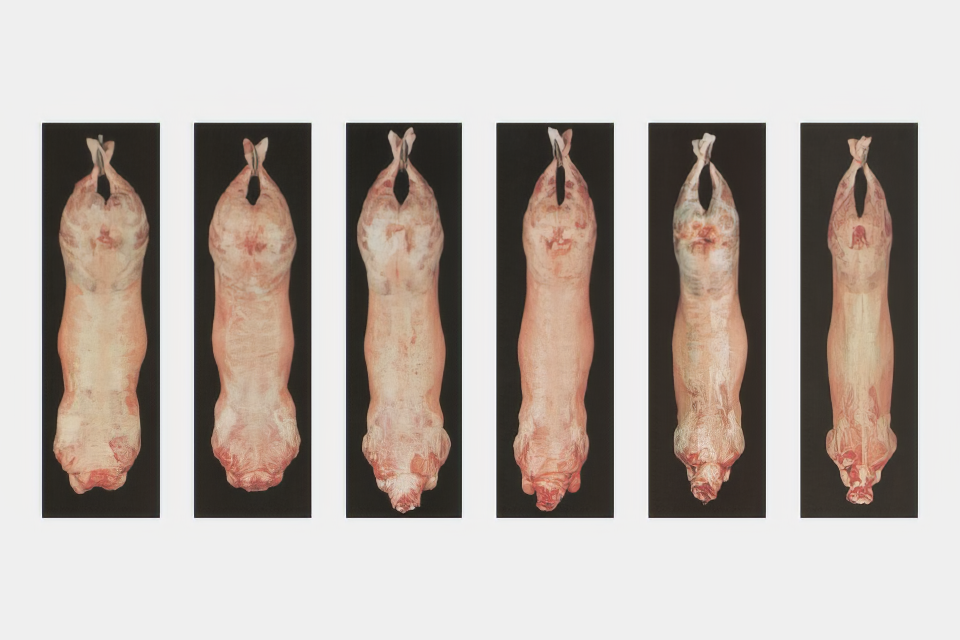
Image showing the (S)EUROP conformation classes. From left to right: S - Superior, E - Excellent, U - Very good, R - Good, O - Fair, P - Poor. Cropped from original.
Community scale for the classification of carcases of ovine animals.
Fat coverage
You need to use the below 5-class classification scale to assess fat cover on carcases of sheep aged less than 12 months. This involves making a visual assessment of the carcase’s external fat development. The 5 classes range from 1 (low) to 5 (very high).
Each of the fat classes can be broken down into 3 optional subclasses of:
- Low (-)
- Medium (=)
- High (+)
If the above optional subclasses are not used for fat classes ‘3 Average’ and ‘4 High’, you must provide a subclass of Low (L) or High (H).
1 – Low
External: Traces of, or no, fat visible.
Internal (abdominal): Traces of, or no, fat visible on kidneys.
Internal (thoracic): Traces of, or no, fat visible between ribs.
2 – Slight
External: A slight layer of fat covers part of the carcase, but may be less evident on the limbs.
Internal (abdominal): Traces of fat, or slight layer of fat envelops part of the kidneys.
Internal (thoracic): Muscle clearly visible between ribs.
3 – Average
External: A light layer of fat covering most, or all, of the carcase. Slightly thickened fat zones at the base of the tail.
Internal (abdominal): Light layer of fat envelops part, or all, of the kidneys.
Internal (thoracic): Muscle still visible between ribs.
4 – High
External: A thick layer of fat covering most, or all, of the carcase; but may be thinner on limbs and thickening on shoulders.
Internal (abdominal): Kidney is enveloped in fat.
Internal (thoracic): Muscle between ribs may be infiltrated with fat. Fat deposits may be visible on the ribs.
5 – Very high
External: Very thick fat cover. Patches of fat sometimes visible.
Internal (abdominal): Kidneys enveloped in thick layer of fat.
Internal (thoracic): Muscle between ribs infiltrated with fat. Fat deposits visible on ribs.
Examples of fat cover
The below image is for illustration purposes only. It supports the documented requirements for each of the classifications above.
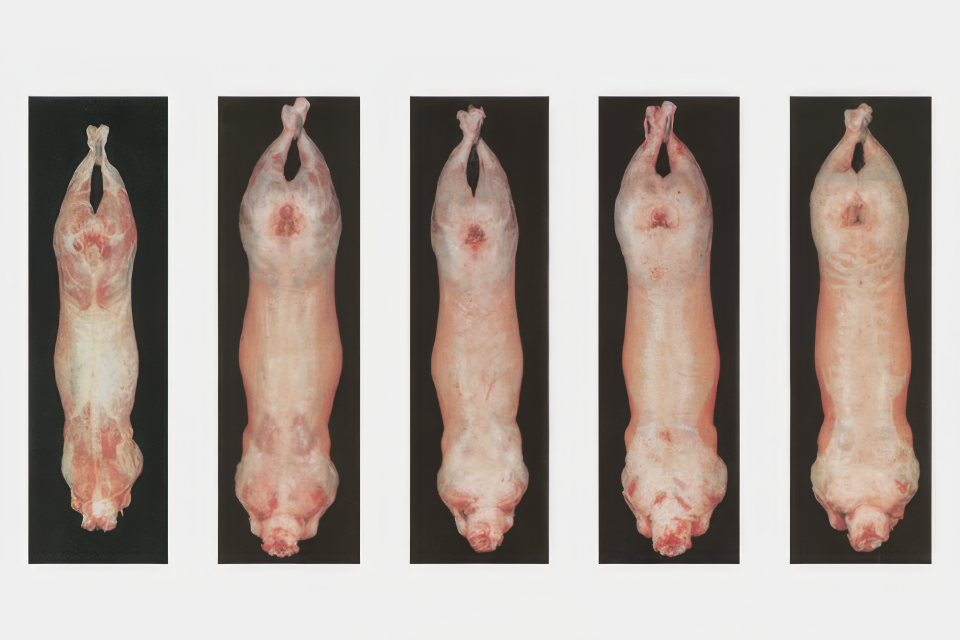
Image showing the fat cover classes. From left to right: 1 - Low, 2 - Slight, 3 - Average, 4 - High, 5 - Very high. Cropped from original.
Community scale for the classification of carcases of ovine animals.
Weigh the carcase
You must determine the cold weight of each carcase that is classified in your slaughterhouse. To determine the cold weight:
- Weigh the carcase to the nearest 100 grams as soon as possible, and within 60 minutes of slaughter. This is the warm weight.
- Calculate 2% of the warm weight and round this to one decimal point. Round down for 0.04 and below. Round up for 0.05 and above. This is the cold weight rebate.
- Deduct the cold weight rebate from the warm weight. This is the cold weight.
Example
Warm weight of lamb at the scale = 18.3kg
Cold weight rebate = 18.3 × 2% = 0.366. Rounded up to one decimal place = 0.4kg
Cold weight of lamb = 18.3 - 0.4 = 17.9kg
Label the carcase
You must label each carcase which has been classified with the mandatory classification details. This must be done at the time of classification.
A classification label can only be changed by the person who originally classified the carcase. They must do this by clearly marking the label.
How to use labels
The label must show:
- the kill number
- the date of slaughter
- the approval number of the slaughterhouse
- the conformation class including subdivisions, if applicable
- the fat cover including subdivisions, if applicable
- the cold weight of the carcase
- if the classification was carried out visually or by automated classification
Labels must be:
- clearly legible
- tamper-proof
- firmly attached to each carcase
Communicate the classification results
You must tell whoever has sent the animal to slaughter the results of the classification in writing. The format you use could be an invoice or attached document.
You must tell them:
- the date of slaughter
- the kill number
- which dressing specification you used
- the cold weight of the carcase
- the conformation class including subdivisions, if applicable
- the fat cover including subdivisions, if applicable
If you cannot tell the person who supplied the animal, you should tell the person or the company responsible for the slaughter operations.
Slaughterhouse operators must keep full records of classification details for at least 12 months from the end of the calendar year that the carcase was classified in.
